"Musical compositions, it should be remembered,
do not inhabit certain countries, certain museums,
like paintings and statues. The Mozart Quintet is
not shut up in Salzburg: I have it in my pocket."
AUTHOR: Henri Rabaud
MEANING OF THE QUOTE:
"Music is an art form that can
be appreciated everywhere."
when he was just 26, Mendelssohn
named his childhood friend
Ferdinand David
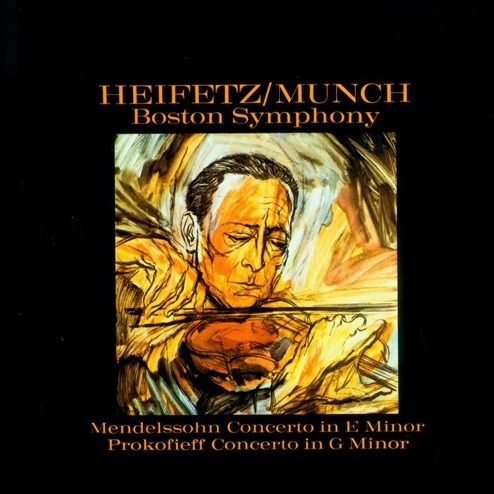
Sir Thomas Beecham, Conductor
Royal Philharmonic, 1949
:format(jpeg):mode_rgb()/discogs-images/R-2463572-1285488217.jpeg.jpg)
Georges Enesco, Conductor
Orchestre des Concerts Colonne, 1938
:format(jpeg):mode_rgb()/discogs-images/R-1672320-1235931877.jpeg.jpg)
Walter Hendl, Conductor
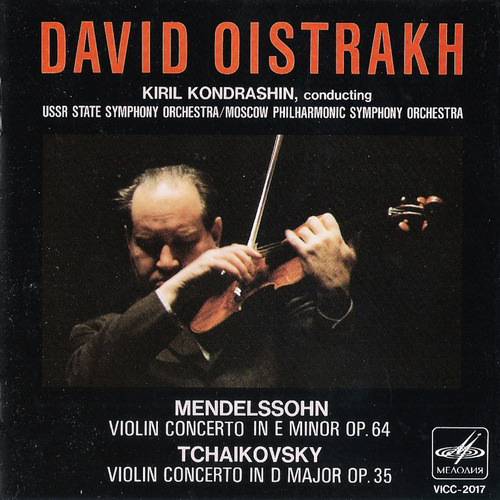
Franz Konwitschny, Conductor
Leipzig Gewandhaus Chamber Orchestra, 1955

COMPOSER
MENDELSSOHN
VIOLIN CONCERTO
IN E MINOR OPUS 64
 |
| John Gulich: A Violin Concerto, 1898 |
VIOLIN CONCERTO
IN E MINOR OPUS 64
Isaac Stern, Violin
:format(jpeg):mode_rgb()/discogs-images/R-4169815-1357564584-7117.jpeg.jpg)
Eugene Ormandy, Conductor
Philadelphia Orchsta, 1958
:format(jpeg):mode_rgb()/discogs-images/R-4169815-1357564584-7117.jpeg.jpg)
Eugene Ormandy, Conductor
Philadelphia Orchsta, 1958
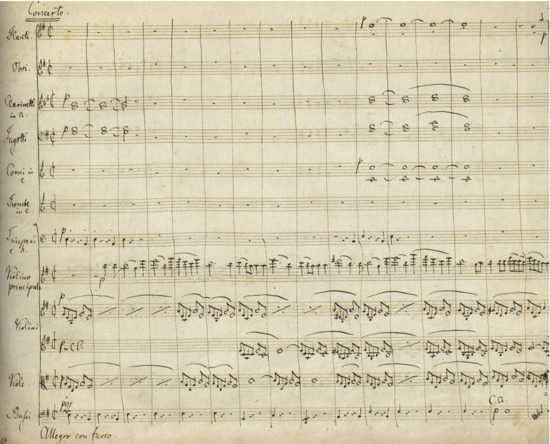 |
| http://www.omifacsimiles.com/brochures/mendel_vc.html |
This piece is one of the most frequently performed
of all violin concerti in violin literature.

I. Allegro molto appassionato
of all violin concerti in violin literature.

I. Allegro molto appassionato
 |
| The opening of the Violin Concerto |
Mendelssohn dispenses with the extended
orchestral introduction that was then the norm
and instead launches straight into the turbulent
first movement's soaring, passionate main
theme after just three beats of a quiet,
throbbing vamp in the orchestra. This main
theme is written in classic sonata form having
a variety of thematic expositions, a development,
and recapitulation of the themes.
orchestral introduction that was then the norm
and instead launches straight into the turbulent
first movement's soaring, passionate main
theme after just three beats of a quiet,
throbbing vamp in the orchestra. This main
theme is written in classic sonata form having
a variety of thematic expositions, a development,
and recapitulation of the themes.
Rather than bringing this movement to a
defined close after the coda, Mendelssohn
has a single bassoon playing a sustained
tone provide the bridge to the overall restful
mood of the second movement.
defined close after the coda, Mendelssohn
has a single bassoon playing a sustained
tone provide the bridge to the overall restful
mood of the second movement.
II. Andante
 |
| The main theme of the Andante |
This slow movement, which is simple in form but
profoundly expressive, is in ternary (ABA) form.
The principal theme is noble, and the violin
develops it through the whole range of the
profoundly expressive, is in ternary (ABA) form.
The principal theme is noble, and the violin
develops it through the whole range of the
instrument in several minutes of unbroken melody.
Again eliminating the standard moments of
silence between movements, Mendelssohn
immediately starts the third movement.
III. Allegretto non troppo-Allegro molto vivace
Composed in hybrid sonata rondo form,
Mendelssohn concludes the concerto with
sprightly, high spirited, vibrant music. The
first theme scampers and flutters; the second
is like a fairy's wedding march. Both main
themes are developed ingeniously ending in
a bustling coda where the music
attains a real noble feeling.
Mendelssohn concludes the concerto with
sprightly, high spirited, vibrant music. The
first theme scampers and flutters; the second
is like a fairy's wedding march. Both main
themes are developed ingeniously ending in
a bustling coda where the music
attains a real noble feeling.
Evidence from Mendelssohn’s correspondence
suggests that he connected the movements into
an uninterrupted span of music because he, as
a performer, found mid-composition applause
to be distracting. It is in part because of
Mendelssohn that the modern tradition of
holding applause to the end of a work came
to be standard practice.
http://www.britannica.com/EBchecked/topic/629700/Violin-Concerto-in-E-Minor-Op-64
http://www.tso.ca/en-ca/Discover-the-Music/Programme-Notes/Violin-Concerto-in-Minor-Op-64.aspx
suggests that he connected the movements into
an uninterrupted span of music because he, as
a performer, found mid-composition applause
to be distracting. It is in part because of
Mendelssohn that the modern tradition of
holding applause to the end of a work came
to be standard practice.
http://www.britannica.com/EBchecked/topic/629700/Violin-Concerto-in-E-Minor-Op-64
http://www.tso.ca/en-ca/Discover-the-Music/Programme-Notes/Violin-Concerto-in-Minor-Op-64.aspx
Following his appointment in 1835 to principal
conductor of the Leipzig Gewandhaus Orchestra,
 |
| The First Gewandhaus Building This was the first concert hall for the orchestra located under the roof of the Trading Halland the guildhall of Leipzig's cloth merchants. |
 |
| The Original Gewandhaus Building A watercolor painted by Mendelssohn |
named his childhood friend
Ferdinand David
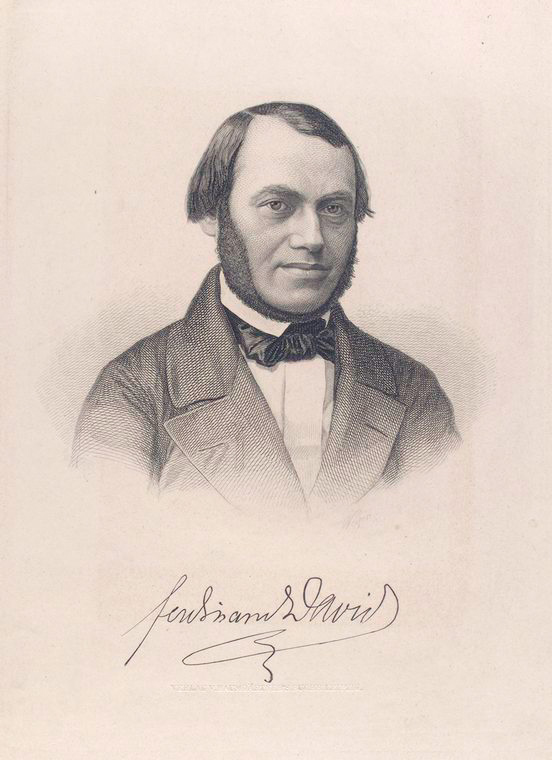 |
| Ferdinand David |
as the orchestra's concertmaster.
The work's origins derive from this professional
collaboration. In a letter dated 30 July 1838,
Mendelssohn wrote to David:
 |
| Hall of the Leipzig Gewandhaus, 1845 |
collaboration. In a letter dated 30 July 1838,
Mendelssohn wrote to David:
"I should like to write a violin concerto for
you next winter. One in E minor runs through my
The concerto took another six years to complete.
There are many possible reasons for the delay,
including self-doubt, his third symphony and an
unhappy period in Berlin after work requests from
his patron King Frederick William IV of Prussia

took up much of his time.
Neverthe-less, Mendelssohn and David
kept up a regular correspondence during
this time, with Mendelssohn seeking
technical and compositional advice. Indeed,
this violin concerto was the first of many to
have been composed with the input of
a professional violinist, and would influence
many future collaborations.

took up much of his time.
Neverthe-less, Mendelssohn and David
kept up a regular correspondence during
this time, with Mendelssohn seeking
technical and compositional advice. Indeed,
this violin concerto was the first of many to
have been composed with the input of
a professional violinist, and would influence
many future collaborations.
The autographed score is dated
September 16, 1844, but Mendelssohn was still
seeking advice from David until its premiere.
The concerto was first performed in Leipzig on
March 13, 1845 with Ferdinand David as soloist.
Mendelssohn was unable to conduct due to illness
and the premiere was conducted by the
Danish composer Niels Gade.
September 16, 1844, but Mendelssohn was still
seeking advice from David until its premiere.
The concerto was first performed in Leipzig on
March 13, 1845 with Ferdinand David as soloist.
Mendelssohn was unable to conduct due to illness
and the premiere was conducted by the
Danish composer Niels Gade.
was scheduled to play her husband Robert's
piano concerto in Dresden, but fell ill
and was unable to take the stage.
Ferdinand Hiller
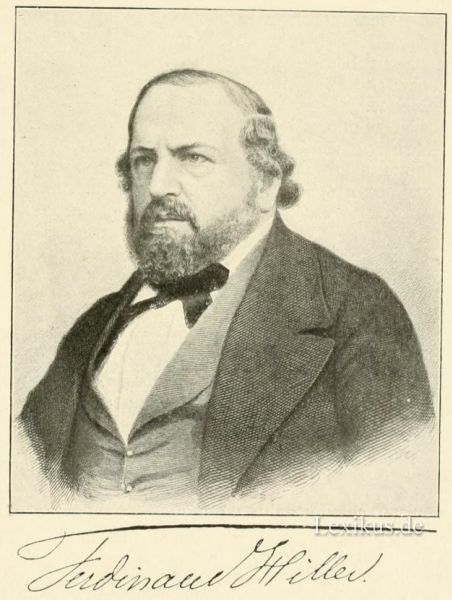
piano concerto in Dresden, but fell ill
and was unable to take the stage.
Ferdinand Hiller

the conductor,
substituted the Mendelssohn
violin concerto. David had a prior
engagement, however, and sent a
pupil, the prodigy, 14-year- old
Joseph Joachim, who had been
studying the work in his stead.
substituted the Mendelssohn
violin concerto. David had a prior
engagement, however, and sent a
pupil, the prodigy, 14-year- old
Joseph Joachim, who had been
studying the work in his stead.
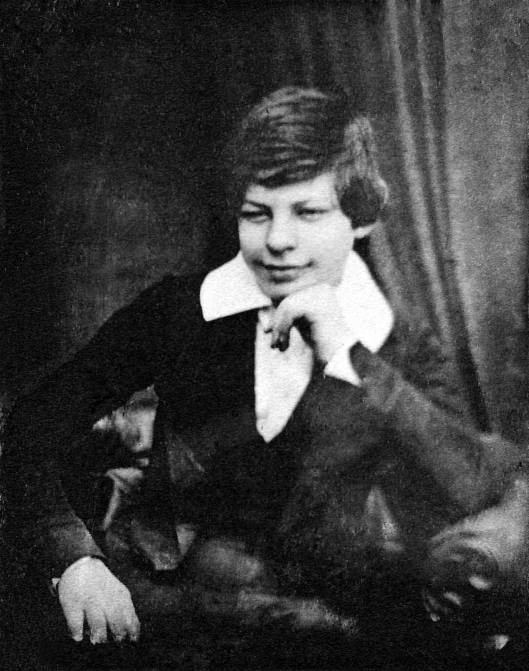 |
Joseph Joachim:
|
He performed masterfully in this outing,
beginning a career that was to make him
the undisputed king of Europe's
19th-Century violinists.
beginning a career that was to make him
the undisputed king of Europe's
19th-Century violinists.
 |
| http://josephjoachim.com/ |
Since Joachim,
this work, with its frequent
lyric and virtuoso passages providing ample
opportunity for a young star to show off
his or her technique and interpretive
 |
| Joachim |
lyric and virtuoso passages providing ample
opportunity for a young star to show off
his or her technique and interpretive
talents, has been used to introduce
many talented young violinists.
Mendelssohn's piece is so important to the
violin teaching repertoire that the famous
violinist/teacher Otakar Ševčík

violin teaching repertoire that the famous
violinist/teacher Otakar Ševčík

specifically for violinists learning this
concerto. These exercises give a walk-
concerto. These exercises give a walk-
through of all the technical issues the
player will face, with exercises based
VIOLIN CONCERTO
IN E MINOR OPUS 64
"Finale"
Eugene Ysaye, Violin
(One of the first recordings of
the Mendelssohn Concerto)
931-uso20101204-004-mendelssohn-violin-concerto-mvtIII.mp3
http://www.classicfm.com/composers/mendelssohn/guides/facts/david-4/
http://en.wikipedia.org/wiki/Violin_Concerto_%28Mendelssohn%29
http://www.britannica.com/EBchecked/topic/629700/Violin-Concerto-in-E-Minor-Op-64
https://archive.org/details/MendelssohnViolinConcertoInEMinormenuhin
http://www.lasr.cs.ucla.edu/geoff/prognotes/mendelssohn/violinCon.html
http://cso.org/uploadedfiles/1_tickets_and_events/program_
notes/programnotes_mendelssohn_violinconcerto.pdf
http://nyphil.org/~/media/pdfs/program-notes/
1314/Mendelssohn-Violin-Concerto.pdf
http://www.tso.ca/en-ca/Discover-the-Music/Programme-
Notes/Violin-Concerto-in-Minor-Op-64.aspx
http://www.violinschool.org/violin-repertoire/mendelssohn-violin-concerto/
http://conquest.imslp.info/files/imglnks/usimg/b/b0/
IMSLP91999-PMLP189293-Mendelssohn_solo_col.pdf
http://www.philharmonia.co.uk/explore/films/514/
listening_guide_mendelssohns_violin_concerto

http://www.classicfm.com/composers/mendelssohn/guides/facts/david-4/
http://en.wikipedia.org/wiki/Violin_Concerto_%28Mendelssohn%29
http://www.britannica.com/EBchecked/topic/629700/Violin-Concerto-in-E-Minor-Op-64
https://archive.org/details/MendelssohnViolinConcertoInEMinormenuhin
http://www.lasr.cs.ucla.edu/geoff/prognotes/mendelssohn/violinCon.html
http://cso.org/uploadedfiles/1_tickets_and_events/program_
notes/programnotes_mendelssohn_violinconcerto.pdf
http://nyphil.org/~/media/pdfs/program-notes/
1314/Mendelssohn-Violin-Concerto.pdf
http://www.tso.ca/en-ca/Discover-the-Music/Programme-
Notes/Violin-Concerto-in-Minor-Op-64.aspx
http://www.violinschool.org/violin-repertoire/mendelssohn-violin-concerto/
http://conquest.imslp.info/files/imglnks/usimg/b/b0/
IMSLP91999-PMLP189293-Mendelssohn_solo_col.pdf
http://www.philharmonia.co.uk/explore/films/514/
listening_guide_mendelssohns_violin_concerto

COMPARE THE PERFORMANCES

Sir Thomas Beecham, Conductor
Royal Philharmonic, 1949
:format(jpeg):mode_rgb()/discogs-images/R-2463572-1285488217.jpeg.jpg)
Georges Enesco, Conductor
Orchestre des Concerts Colonne, 1938
:format(jpeg):mode_rgb()/discogs-images/R-1672320-1235931877.jpeg.jpg)
Walter Hendl, Conductor

Franz Konwitschny, Conductor
Leipzig Gewandhaus Chamber Orchestra, 1955
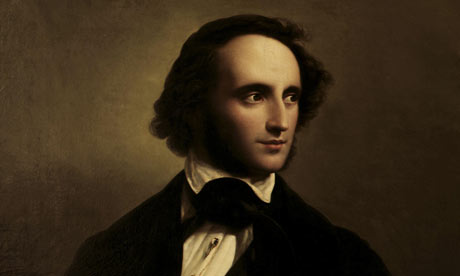



.jpg)
.jpg)
.jpg)
.jpg)
.jpg)


.jpg)
.jpg)
.jpg)
.jpg)
.jpg)